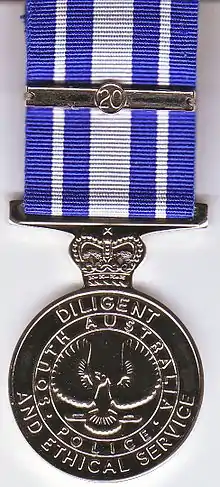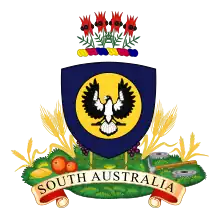South Australia Police
South Australia Police (SAPOL) is the police force of the Australian state of South Australia. SAPOL is an independent statutory agency of the Government of South Australia directed by the Commissioner of Police, who reports to the Minister for Police. SAPOL provides general duties policing, highway patrol, criminal investigation and emergency coordination services throughout the state. SAPOL is also responsible for road safety advocacy and education, and maintains the South Australian Road Safety Centre.
| South Australia Police | |
|---|---|
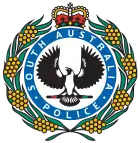 Badge of the South Australia Police | |
 Flag of the South Australia Police | |
| Motto | Safer Communities |
| Agency overview | |
| Formed | 28 April, 1838 |
| Employees | 6049 (2021)[1] |
| Jurisdictional structure | |
| Operations jurisdiction | |
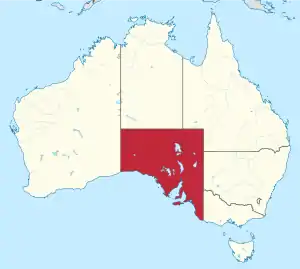 | |
| South Australia Police jurisdiction | |
| Size | 1,043,514 square kilometres (402,903 sq mi) |
| Population | 1,767,247 (2020) |
| Legal jurisdiction | As per operations jurisdiction |
| Governing body | Government of South Australia |
| Constituting instrument |
|
| General nature | |
| Operational structure | |
| Overviewed by | Independent Commission Against Corruption |
| Headquarters | 100 Angas Street Adelaide SA 5000 34°55′36.07″S 138°36′3.25″E |
| Minister responsible |
|
| Agency executive | |
| Units | List
|
| Facilities | |
| Stations | 138 |
| Website | |
| www.police.sa.gov.au | |
As of November 2022 the commissioner of police is Grant Stevens, who has been in the role since July 2015.
History


Early years
Formally established on 28 April 1838 under the command of Inspector Henry Inman, the force is the oldest in Australasia and is the third oldest organised police force in the world. The first force in the colony of South Australia consisted of 10 mounted constables and 10 foot constables.[2]

In 1840, Major Thomas Shouldham O'Halloran was appointed as the first official Commissioner of Police. At this time, SAPOL consisted of one Superintendent, two Inspectors, three Sergeants and 47 Constables divided into foot and mounted sections.[2]
From 1848 to 1867, SAPOL also served as the state fire and rescue service, until the precursor of the South Australian Metropolitan Fire Service was formed. They also supplied the Civil Ambulance Service from 1880 to 1954, when it was taken over by the St John Ambulance Service.[2]
Female officers
In 1915, the first two female police officers, Kate Cocks and Annie Ross, were appointed. This was six months after New South Wales commenced with two officers. It had been said "it is easier to get into heaven than to join the women police".[3] Cocks retired in 1935, and was the officer in charge of the largest female detachment of all Australian state police departments of 14, which was double the size of the next-nearest of New South Wales.[4]
In 1929, officer Miss Daisy Curtis studied on a scholarship abroad to examine the 'methods of protecting women and children'.[5] This included travels to the jurisdictions of Great Britain, Norway, Sweden, Germany, the Netherlands, the United States of America, and New Zealand. (New Zealand did not get it first female officer until 1941.)
In 1999, SAPOL was the first Australian policing jurisdiction to appoint a female police officer, Senior Constable Jane Kluzek, to a tactical group.
Timeline of initiatives
- 1893: Introduced bicycles for metropolitan and country foot police
- 1893: Pioneered the fingerprint system in Australia
- 1987: The first Australian police service to introduce videotaping of "suspect person" interviews
- 1993: Introduced Operation Nomad, as a policing initiative to reduce the threat of bushfires
- 1996: Crime Stoppers launched
- 2000s: Established neighbourhood policing teams in various metropolitan areas
- 2011: The first police jurisdiction in Australia to launch its own web platform connecting mobile phone users to the latest police news
Responsibilities
Commissioner
The commissioner of police, in addition to leading SAPOL, also serves as the State Emergency Coordinator and is responsible for major emergency response and command and control of major disasters,[6] including bushfires, floods, and earthquakes. Under an emergency declaration the commissioner is extraordinary authority to create rules and regulations that may be enforced by police, for a limited time. Due to these laws, Commissioner Grant Stevens became a central figure in South Australia's response to the COVID-19 pandemic.[7] The powers of South Australia Police are defined in the Police Act 1998.[8]
SAPOL
In addition to general law enforcement such as patrols and investigations, SAPOL is responsible for other services throughout the state. These include:[9]
- Operating emergency assistance call centres for police, 000 (emergency telephone number)
- Non-urgent assistance call centres, 131 444 (non-emergency telephone number)
- Coordinating and managing emergency disaster response
- Road safety advocacy and education
- Registration and licensing of firearms
- Liquor licensing enforcement
- Security of public buildings and officials
- Police prosecutions
- Victim support services
Organisation
SAPOL's structure consists of various units. Through the chain of command, all units are accountable to the Commissioner. Services are the largest units, and are headed by a sworn assistant commissioner, or for areas which are not policing specific, such as information technology, a civilian Director. Services are directly accountable to either the Commissioner or Deputy Commissioner.[10][11]
Services within metropolitan Adelaide are based on four different districts: North, East West and South. Each district has its own localised branch that provides specialised services or assistance, such as Criminal Investigation Branch (CIB), family violence, and intelligence sections. There are seven local service areas (LSAs) for remote and country areas within the remainder of the state.[12]
Districts and local service areas
Districts and LSAs are the main organisational unit to provide policing services to the public. A district and local service area contains a number of police stations, as well as specialist services to support frontline police such as detectives, crime scene investigators and traffic police.[13] Each LSA has a designated office known as a 'Complex' where majority of operations in the area start. The LSA then have smaller community police stations for quick policing access.
Metropolitan districts and LSAs are divided into the Metropolitan Operations Service and the State Operations Service, which each have their own coordination branch and some other additional functions.[14]
Metropolitan Districts (Metropolitan Operations Service)
- Eastern District
- Northern District
- Southern District
- Western District
- Metropolitan Operations Service Coordination Branch
- Public Transport Safety Section[15]
Local Service Areas (State Operations Service)
- Barossa LSA
- Eyre and Western LSA
- Far North LSA
- Hills Fleurieu LSA
- Limestone Coast LSA
- Murray Mallee LSA
- Yorke Mid North LSA
- State Operations Service Coordination Branch
- State Operations Support Branch
- Traffic Services Branch (Highway Patrol)
- Stations
 Gawler Police Station
Gawler Police Station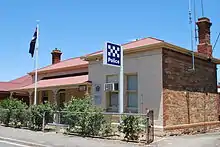 Hamley Bridge Police Station
Hamley Bridge Police Station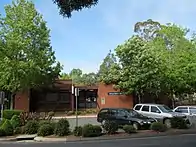 Stirling Police Station
Stirling Police Station
Security and Emergency Management Service
Security and Emergency Management is led by an Assistant Commissioner.[16]
- Security and Emergency Management Service Coordination Branch
- Communications Group
- Police Security Services Branch
- Security Advice Section
- Special Tasks and Rescue Group (STAR Group)
- STAR Group Police Tactical Group
- Dog Operations Unit
- Mounted Operations Unit
- Water Operations Unit
- PolAir
- Bomb Squad
- Negotiators
- Security Response Section[17]
- State Protective Security Branch (Police Security Officers)[18]
Operations Support Service
Operations Support is led by an Assistant Commissioner.[19]
- Operations Support Service Coordination Branch
- Firearms Branch
- Forensic Services Branch
- Licensing Enforcement Branch
- Prosecution Services Branch
- State Intelligence Branch
Crime Service
Crime Service is led by an Assistant Commissioner, usually a former Detective.[20]
- Serious Crime Coordination Branch
- Financial and Cybercrime Investigation Branch
- Investigation Support Branch
- Major Crime Investigation Branch
- Public Protection Branch
- Serious and Organised Crime Branch
Governance and Capability Service
Governance and Capability is led by an Assistant Commissioner.[21]
- Governance and Capability Service
- Coordination Branch
- Commissioner’s Support Branch
- Communication and Engagement Branch
- Ethical and Professional Standards Branch
- Office of the General Counsel
Other services
Each administrative service is led by a civilian Executive Director.[22]
- Business Service
- Information Systems and Technology Service
- People Culture and Wellbeing
Ranking and structure
Police Officers

| Probationary Constable | Constable | Constable | Senior Constable | Senior Constable First Class | Brevet Sergeant | Sergeant | Senior Sergeant | Senior Sergeant First Class |
 |  |
 |
 |  |  |  |  |  |
|---|
All grades of constable perform the same basic range of duties, with the rank only reflecting experience. The rank of probationary constable is held for the first fifteen months of service. A constable with one stripe is qualified for promotion to senior constable. A senior constable first class is either an officer qualified for promotion to sergeant/senior sergeant or has won a senior constable first class position on merit. A brevet sergeant is the second in charge of a team and it can be a temporary designation for an officer in a particular position which would require specialised skills, such as a detective.
A sergeant normally manages a team during a shift. A sergeant may also manage a small country station. A detective sergeant is normally in charge of a team in an investigations section. As with a sergeant, a detective sergeant may be the officer in charge of a country CIB unit. A senior sergeant is the officer in charge of a section, including traffic, criminal investigation, and operations (uniform), and traditionally does more administrative work than active patrol duties.
| Inspector | Chief Inspector | Superintendent | Chief Superintendent | Commander | Assistant Commissioner | Deputy Commissioner | Commissioner |
 |  |  |  |  |  |  |  |
Officers of Police were formerly known as commissioned officers. This name was changed as SAPOL officers no longer receive a Queen's Commission. Officers of Police act primarily as managers and generally do not partake in operational policing. An Inspector is in charge of a section. A detective inspector is normally in charge of the whole station CIB. A uniform inspector is normally in charge of the station's operations.
A chief inspector commands a department at station level. A uniform chief inspector is in charge of all uniformed officers, regardless of their attachments to assigned areas (e.g. general duties, traffic duties etc.). Some country LSAs have chief inspectors as the regional commander. A detective chief inspector is in charge of all CIB-related matters.
Superintendents, chief superintendents and commanders may be the manager of a Local Service Area or Branch, such as the Major Crime Branch. An LSA commander is generally a superintendent. A chief superintendent may be the manager of a specialised area, such as a Service Coordination Branch. Few commanders are appointed. The Industrial Relations Branch has a commander as its officer in charge.
An assistant commissioner is the manager of a service, such as Northern Operations Service or Crime Service.
The Deputy Commissioner is the assistant to the Commissioner, who commands the organisation.
Police Security Officers
Police Security Officers (PSOs) (formerly Protective Security Officers) are armed security police officers originally employed by SAPOL to perform security functions at government properties, to provide security to protected persons (such as the Governor of South Australia) and to monitor metropolitan CCTV cameras.[24] PSOs functions and duties have over time increased to include duties traditionally performed by sworn Police Officers.[25] PSOs normally have limited powers and are limited to using those power in prescribed circumstances or locations, however, under current legislation passed in 2022, PSOs duties may be extended by the Commissioner of Police and they may be granted full police powers and immunities in the performance of those duties.[26] PSOs were utilised in the states response to the COVID-19 pandemic. PSOs have their own rank structure.
| Police security officer trainee | Police security officer first class | Police security officer supervisor |
 |  |  |
Uniform and equipment
Uniforms
.jpg.webp)
SAPOL issues uniforms to sworn police officers. Police officers working in non-specialised areas generally wear a standard uniform, which consists of a navy blue collared shirt with attached police badges and navy blue slacks. Short and long sleeve shirts are worn as preferred. Police officers can choose between either a dark blue peaked hat or an Akubra wide-brimmed hat and are not required to wear a tie. Baseball caps are worn in specialist areas, including STAR Group, Crime Scene, State Traffic Enforcement Section, and by Operational Safety Trainers. Officers in northern country areas wear khaki uniforms instead of blue. PSOs (Police Security Officers) wear slightly different shirts. The shirts and slacks are also navy blue, but they have golden markings and PSO markings. In the past, the shirt was white. This was changed at the end of 2019.
In 2010 SAPOL started consultations on a new darker uniform reminiscent of those worn by officers of the NYPD and LAPD. In 2012 SAPOL announced the new uniform would be introduced in mid-October 2012 and would be rolled out over 18 months.[28] The only visible change from the consultation period was to the peaked cap. The white peak was changed to the same dark blue as the shirt and pants, which is called ink blue. SAPOL has implemented the use of stab-resistant vests for all patrol officers, PSOs and Police dogs.[29][30]
Equipment and weaponry
Standard equipment issued to almost all officers are:
- Smith & Wesson M&P .40 S&W semi-automatic pistol
- Pepper spray
- ASP Extendable Baton
- Handcuffs
- Taser
- Light ballistic vest[31]
- Bodycam[32]
Criminal Investigation Officers are issued with the compact version of the semi-automatic pistol (M&Pc). Specialised units such as Special Tasks and Rescue (STAR Group) use other equipment suited to the nature of their duties. SA Police were among the last to carry revolvers as a duty weapon. They carried Smith & Wesson Model 66 (a variant of the Model 19) revolvers in .357 Magnum until the switch to the Smith & Wesson M&P semi automatic in 2009.[33]
Drones have been used for surveillance since June 2013.[34]
In July 2020, a new rapid response armed unit the Security Response Section consisting of 48 officers who carry semi-automatic rifles became operational.[17][35][36]
Transport
Vehicles
SAPOL officers use a number of vehicles in day-to-day duties. Throughout its history SAPOL has mostly used the Holden Commodore as its primary vehicle. Since the phasing out of the Holden Commodore SAPOL has recently switched to the Kia Sorento and Toyota RAV 4 as general duties vehicles.[37]
The Volkswagen Tiguan has recently been introduced primarily for traffic related duties. SAPOL also uses vehicles including the Toyota Kluger, Mitsubishi Outlander and Toyota Camry. Also used are VW Transporter, Toyota Hilux, Holden Colorado, Isuzu D-MAX caged vehicles for prisoner transport and the 2-Door Ford Ranger with canopy for the Dog Operations Unit. In remote country areas, Toyota Land Cruisers and Troop Carriers are used as primary patrol vehicles. Patrol cars are used in both marked and unmarked variants, with the latter being a bit more extensive in its vehicle composition. SAPOL have also, in previous years, used high performance vehicles such as Holden's SS Commodore for traffic operations. High Ranking Commissioned Officers are issued unmarked top of the range vehicles. In the past it has been the Holden Calais and Holden Acadia LTZ-V SUV and currently the Kia Sorrento SUV.
Members of the State Traffic Enforcement Section ride marked and unmarked Honda and BMW motorcycles for traffic, escort, and other duties.
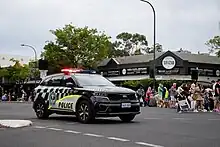 A state traffic services Kia Sorrento
A state traffic services Kia Sorrento.jpg.webp) A local traffic enforcement Holden ZB Commodore
A local traffic enforcement Holden ZB Commodore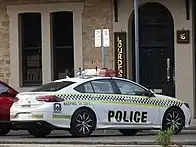 A General Duties car
A General Duties car
Specialised vehicles
SAPOL utilise specialised Vehicles which are used in a wide variety of ways, for example, as a mobile police station/unit at a large public function, or as forward command posts at search and rescues, or other incidents such as siege or hostage situations. STAR Group also possess a Lenco BearCat armoured vehicle available for use in a siege or terrorist situations.[38]
Watercraft
The SAPOL Water Operations Unit uses a number of watercraft including boats and Jet Skis to police coastal and inland waterways.[39][40]
Mounted branch

For ceremonial activities, crowd control and patrol duties, the SAPOL Mounted Operations Unit use grey horses. They are bred and trained at the Thebarton Police Barracks, in Park 27 of the Adelaide Park Lands, just northeast of the Adelaide city centre. These "police greys", as they are known, are ideal for police work as the light grey tones make the horse highly visible at night. They are also highly recognisable in the community and are often involved in community events such as leading the annual Credit Union Christmas Pageant and ANZAC Day parade.[41] The Thebarton Police Barracks will be under the South Australian Governments plan to replace the current Women's and Children's Hospital and replaced with a new facility. [42]
Aircraft
Members of STAR Group and Transit Services Branch act as crew members on a modified Bell 412 Helicopter (callsign PolAir 53) which features an array of thermal and imaging sensors and is marked in a SAPOL livery.[43] SAPOL also use a Pilatus PC-12 aircraft which is used to convey Police and prisoners across the state.[44]
_Pilatus_PC-12-47E_parked_at_Wagga_Wagga_Airport_(1).jpg.webp) Pilatus PC-12/47E of South Australia Police
Pilatus PC-12/47E of South Australia Police
Training and education
Recruit training is conducted at the SAPOL Police Academy located adjacent to the old barracks adjacent to Fort Largs in the north-western Adelaide suburb of Taperoo. Cadets undergo a 52-week course, called the "Constable Development Program" (CDP). The CDP is broken down into five phases, which includes training at the Police Academy and field experience at metropolitan LSAs. Police cadets learn law, about investigations and police procedures. During recruit training, non-officers (police staff and volunteers) assist with various duties, such as cadet assessment, role playing and general administration. Cadets also undertake operational safety training, including self-defence and the use of firearms. Practical role-playing and assessments are part of the course.[45] Training with police dogs and police horses is offered at the Thebarton Police Barracks. Earlier, training was being held at the older Academy located next to the present one.
Graduation and aftermath for new officers
Cadets graduate with the rank of probationary constable and are subject to a 15-month period of on-the-job training. Probationary Constables are required to work with a Field Tutor for the first 6 months of the probationary period whilst they complete a Personal Learning Portfolio. Probationary Constables also undertake a range of duties to enhance their learning, including traffic, prisoner management, and general duties. For the following 6 months, probationary constables continue to collect evidence of their workplace competency before attending the Probationary Constable Assessment Workshop to determine whether they are suitable to progress to the rank of Constable. Upon completion of the probationary period, officers receive a Diploma of Public Safety (Policing) and are appointed to the rank of Constable.[46]
Training is ongoing and further courses are available for officers to attend, should they wish to progress their policing career further.
SAPOL Protective Security Officers also undergo training at this location. The duration of this training course is only 12 weeks.
Radio communications
SAPOL refers to the communications operation as "VKA". At 0400 hours (4am) on Tuesday 10 December 2002, SAPOL officially switched from standard 64 UHF channels to the SA Government Radio Network (SAGRN). This utilised digital encrypted radio transmissions meaning that scanners could not listen to police communications. While at first there seemed to be technical issues with the new system, they were quickly resolved and the department now has full trust in the system.
SAPOL still have UHF licences and it is plausible they are available as back-up communication channels. SAPOL uses three primary devices for voice communication over the network. They are Spectra W7 mobile, XTS 5000 portable and Spectra W3 mobile. These can be controlled via the RCH3000 desktop controller, used in fixed locations generally by trained operators.
These devices have a number of features that are regularly used in patrols. These features include private call, page alert and telephone interconnect.
Private call allows units to directly talk to another unit without dispatch, or other users in the talkgroup to hear. However, this comes with the inability for dispatch to contact either unit. Page function alerts another radio that someone else is attempting to contact them. Telephone interconnect enables units to make and answer calls through the system. However, only supervisors have the ability to make and answer to any number, general patrols are restricted to only a list of certified SAPOL numbers. Each LSA has two assigned 'talkgroups'.
COMCEN (Communications) have assigned talkgroup IDs, allowing them to pair an LSA's primary and secondary talkgroups together allowing control to manage two channels at once. The Secondary channel is often used for local/chat, dispatch lowers the volume of the secondary channel, which enables them to monitor the channels and talk to all units on duty in the LSA.[47]
Call signs and unit designation identification system
SAPOL use location-based call signs. Units are called in by stating the station they come from followed by a designated number.
Examples:
- A unit in Holden Hill could be Holden Hill 16.
- Traffic Services place a zero (0) before the number, for example, Holden Hill 016 would be a traffic patrol in Holden Hill with the call sign 16.
- Higher-ranked officers have a different prefix. This is followed after the station name, and before the unit number:
- Sergeant = Vixen
- Senior sergeant = Mitre
- Inspector/chief inspector = Trojan
- Superintendent/chief superintendent = Baron
- Example: Holden Hill Mitre 10 is a senior sergeant in Holden Hill with the unit number 10.[48]
Notable incidents
In 1988, Detective Chief Inspector Barry Moyse - formerly in charge of the drug squad - was convicted of trafficking heroin and other drugs that he had seized from dealers, and sentenced to 21 years imprisonment, of which he served ten years before being paroled. He died in 2010 at the age of 65.[49]
In 1994, a bombing at the National Crime Authority Adelaide offices killed Western Australian Police Det Sgt Geoffrey Bowen and severely injured others. The bomb was concealed in a parcel that was addressed to Bowen. Domenic Perre, who had been identified as a person of interest shortly after the bombing and a known crime figure was convicted of the bombing in 2022.[50][51]
During the 2016 South Australian blackout, SAPOL Commissioner Grant Stevens declared a major incident under the Emergency Management Act. During the incident, Police Officers who were not responding to distress calls were ordered to undertake traffic control duties in the stormy conditions due to all traffic lights around the state becoming inoperable.[52]
List of commissioners
| Rank | Name | Post-nominals | Term began | Term ended | Time in appointment | Notes |
|---|---|---|---|---|---|---|
| Inspector (Commander) | Henry Inman | 28 April 1838 | 18 May 1840 | 2 years, 20 days | [note 1][53] | |
| Commissioner (Major) | Thomas Shuldham O'Halloran | 8 June 1840 | 3 April 1843 | 2 years, 299 days | [note 2][54] | |
| Commissioner | Boyle Travers Finniss | 13 April 1843 | 12 May 1847 | 4 years, 29 days | [note 3][55] | |
| Commissioner | George Frederick Dashwood | 12 May 1847 | 31 December 1851 | 4 years, 233 days | [note 4] | |
| Commissioner | Alexander Tolmer | 28 January 1852 | 29 November 1853 | 1 year, 305 days | [note 5] | |
| Commissioner (Colonel) | Peter Warburton | 29 November 1853 | 13 February 1867 | 13 years, 76 days | [note 6] | |
| Commissioner | George Hamilton | 13 February 1867 | 24 May 1882 | 15 years, 100 days | [56] | |
| Commissioner | William John Peterswald | 3 May 1882 | 30 August 1896 | 14 years, 119 days | [note 7] | |
| Commissioner | Lewis George Madley | ISO, VD | 9 September 1896 | 31 December 1909 | 13 years, 113 days | |
| Commissioner | William Henry Raymond | 1 January 1910 | 30 June 1917 | 7 years, 180 days | ||
| Commissioner | Thomas Edwards | 30 June 1917 | 30 June 1920 | 3 years, 0 days | ||
| Commissioner (Brigadier General) | Sir Raymond Leane | CB, CMG, DSO & Bar, MC, VD | 1 July 1920 | 30 June 1944 | 23 years, 365 days | [note 8] |
| Commissioner | William Francis Johns | CBE | 1 July 1944 | 1 July 1950 | 6 years, 0 days | [57] |
| Commissioner | Ivor Bren Green | LVO | 1 July 1950 | 10 April 1957 | 6 years, 283 days | [note 9][58] |
| Commissioner (Brigadier) | John McKinna | CMG, CBE, DSO, LVO, ED | 1 July 1957 | 1 June 1972 | 14 years, 336 days | |
| Commissioner | Harold Salisbury | QPM | 1 June 1972 | 17 January 1978 | 5 years, 230 days | [note 10] |
| Commissioner | Laurence Draper | QPM | 19 January 1978 | 27 May 1982 | 4 years, 128 days | [59] |
| Commissioner | John Bryan Giles | AO, GM, BEM, QPM | 27 May 1982 | 30 June 1983 | 1 year, 34 days | [60][61][62][63] |
| Commissioner | David Hunt | AO, QPM | 30 June 1983 | 31 December 1996 | 13 years, 184 days | [64][65][66] |
| Commissioner | Malcolm Hyde | AO, APM | 10 February 1997 | 20 July 2012 | 15 years, 161 days | [67][68][69] |
| Commissioner | Gary Burns | BM, APM | 20 July 2012 | 20 July 2015 | 3 years, 0 days | [70][71][72] |
| Commissioner | Grant Stevens | APM | 21 July 2015 | Incumbent | 8 years, 96 days |
Notes
- Position titled 'Officer in Charge of the South Australia Police Force'.
- First to be titled 'Commissioner'. Resigned in order to serve as Police Magistrate.
- Later the first Premier of South Australia.
- Member of Legislative Council
- A veteran of the Portuguese Liberal Wars (1828–1834), Tolmer had been awarded by Queen Maria II of Portugal with the Knight of the Order of the Tower and Sword.
- Dismissed from office.
- Died in office.
- Crushed the Port Adelaide wharf strike of 1928. Knighted in 1945.
- Died in office.
- Dismissed by Premier Don Dunstan for misleading parliament about the existence of the Special Branch and the information it had collected, particularly on Australian Labor Party politicians and the 'pink files' on known homosexuals.
References
- "Annual Report 2020 - 2021" (PDF). South Australia Police. Retrieved 3 November 2022.
- "Milestones of South Australia Police History". South Australian Police Historical Society. Retrieved 5 November 2022.
- "Miss Kate COCKS". Recorder. No. 8, 165. South Australia. 15 April 1925. p. 2. Retrieved 18 December 2021 – via National Library of Australia.
- "The silent service". The Advertiser (Adelaide). South Australia. 29 June 1934. p. 20. Retrieved 18 December 2021 – via National Library of Australia.
- "Policewoman Daisy CURTIS". Observer. Vol. LXXXVI, no. 4, 467. South Australia. 2 February 1929. p. 60. Retrieved 18 December 2021 – via National Library of Australia.
- "State Emergency Management Plan" (PDF). Retrieved 5 November 2022.
- "SA Police Commissioner Grant Stevens looks back on the difficult decisions around the COVID-19 response". ABC News. 25 May 2022.
- "Police Act 1998". South Australian Legislation. 22 November 2021. Retrieved 5 November 2022.
- Police, South Australia. "Who we are". www.police.sa.gov.au.
- "South Australia Police – Structure". South Australia Police. Retrieved 9 June 2011.
- "South Australia Police – Services Structure". South Australia Police. Retrieved 9 June 2011.
- "District Policing: a more visible, responsive police service for metropolitan Adelaide" (PDF). Government of South Australia.
- "Eastern Adelaide LSA". South Australia Police. Retrieved 10 June 2011.
The LSA provides a range of services including Operations, Traffic, CIB, Intelligence and Crime Prevention.
- "South Australia Police - Organisational structure" (PDF). www.police.sa.gov.au. Retrieved 5 November 2022.
- "Public Transport Safety Branch". police.sa.gov.au. South Australia Police. 28 August 2014. Retrieved 19 August 2016.
- "South Australia Police - Organisational structure" (PDF). www.police.sa.gov.au. Retrieved 5 November 2022.
- Minister for Police Corey Wingard (1 July 2020). "SA Police launch new Security Response Section to keep South Australia safe". Premier of South Australia (Press release). Retrieved 17 July 2020.
- "Achievemore - Protective Security Officer Careers". SAPOL - Home. 13 April 2017. Retrieved 8 July 2020.
- "South Australia Police - Organisational structure" (PDF). www.police.sa.gov.au. Retrieved 5 November 2022.
- "South Australia Police - Organisational structure" (PDF). www.police.sa.gov.au. Retrieved 5 November 2022.
- "South Australia Police - Organisational structure" (PDF). www.police.sa.gov.au. Retrieved 5 November 2022.
- "South Australia Police - Organisational structure" (PDF). www.police.sa.gov.au. Retrieved 5 November 2022.
- "South Australia Police – Rank Insignia". The International Encyclopedia of Uniform Insignia Around the World. Retrieved 30 December 2007.
- Police, South Australia. "Police Security Officer Careers". www.police.sa.gov.au.
- Hunt, Nigel. "Change of policing roles plan to alleviate cop resource crisis". The Advertiser. News Corp. Retrieved 5 November 2022.
- "STATUTES AMENDMENT AND REPEAL (BUDGET MEASURES) ACT 2021". South Australian Legislation. 22 November 2021. Retrieved 5 November 2022.
- Police, South Australia. "Working as a Police Security Officer". www.police.sa.gov.au.
- "South Australian police uniform gets an update". Herald Sun. Retrieved 5 October 2012.
- "SA Police to be given stab-proof vests as part of new $8.5 million budget spend". www.9news.com.au.
- "SA Police dogs get stab-proof vests". ABC News. 28 July 2017.
- "SA Police to be given stab-proof vests as part of new $8.5 million budget spend". www.9news.com.au.
- SAPOL bodycam announcement
- "Smith & Wesson to Equip South Australia Police Force". Police1. Retrieved 25 July 2020.
- Crouch, Brad; Hunt, Nigel (29 June 2013). "Police to use drones to spy from sky". Adelaide Now. Retrieved 8 July 2020.
- "SA Police deployment of 'highly visible' heavily armed unit prompts public backlash". ABC News. Australian Broadcasting Corporation. 3 July 2020. Retrieved 17 July 2020.
- Minister for Police Corey Wingard (3 March 2020). "House of Assembly answer to question - Security Response Section". Hansard. Parliament South Australia. Retrieved 17 July 2020.
- "Trial of new SA Police vehicles". Mirage News. 20 August 2020. Retrieved 13 August 2022.
- "SAPOL's latest security weapon". SA Police News. Retrieved 9 June 2011.
- "Investment in new assests pays dividends". Blueprint Magazine (1): 21. 3 May 2022. Retrieved 5 November 2022.
- "SA Police launches new jet skis to patron SA's waterways". Mirage News. 6 October 2020.
- "Special Tasks and Rescue Group". South Australia Police. Retrieved 10 June 2011.
- "Look back at the heritage buildings of Adelaide that have disappeared like the Thebarton Police Barracks will soon". ABC News. 24 February 2023. Retrieved 25 February 2023.
- "Investment in new assests pays dividends". Blueprint Magazine (1): 21. 3 May 2022. Retrieved 5 November 2022.
- "SAPOL aircraft featured in photo shoot over Adelaide". Mirage News. 3 July 2019. Retrieved 5 April 2022.
- "Achieve More". South Australia Police Recruiting Section. Retrieved 13 June 2011.
- "Achieve More". South Australia Police Recruiting Section. Retrieved 13 June 2011.
- "SA Scan – South Australian Scanner Monitoring". www.sascan.net.au.
- "SA Scan – South Australian Scanner Monitoring". www.sascan.net.au.
- "Disgraced ex-drug squad boss dies". Australian Broadcasting Commission. 2 September 2010. Retrieved 24 December 2021.
- Hayman, Dion (6 October 2022). "NCA bomber to be sentenced, likely to die in jail". InDaily.
- "'Today's verdict will allow us to move forward': Family, friends of NCA bombing victims praise Perre conviction". ABC News. 30 June 2022.
- "Power 'gradually' returning after SA plunged into darkness". ABC News. 28 September 2016.
- Max Slee Inman : first commander of the South Australia Police, Seaview Press (Adelaide 2010) ISBN 978-1-74008-559-5.
- Bruce Ross, D. (1967). "Finniss, Boyle Travers (1807–1893)". Australian Dictionary of Biography. National Centre of Biography, Australian National University. Retrieved 17 March 2015.
- "Finniss, Boyle Travers (1807–1893)". Australian Dictionary of Biography. National Centre of Biography, Australian National University. 1966. Retrieved 17 March 2015.
- J. H. Love (2005). "Hamilton, George (1812–1883)". Australian Dictionary of Biography. National Centre of Biography, Australian National University. Retrieved 17 March 2015.
- "JOHNS, William Francis – Commander of the Order of the British Empire". It's an honour database. Australian Government. 1 January 1946. Retrieved 17 March 2015.
- "GREEN, Ivor Bren – Lieutenant of the Royal Victorian Order". It's an honour database. Australian Government. 27 April 1954. Retrieved 17 March 2015.
In recognition of service during the 1954 Royal Visit
- "DRAPER, Laurence Desmond – Queen's Police Medal". It's an honour database. Australian Government. Retrieved 17 March 2015.
- "GILES, John Bryan – Officer of the Order of Australia". It's an honour database. Australian Government. 26 January 1984. Retrieved 17 March 2015.
For public service in the South Australian Police Force
- "GILES, John Bryan – George Medal". It's an honour database. Australian Government. 29 July 1952. Retrieved 17 March 2015.
South Australia Police: Apprehend an armed man
- "GILES, John Bryan – British Empire Medal". It's an honour database. Australian Government. 25 September 1962. Retrieved 17 March 2015.
GALLANTRY:SA Police: Disarm deranged man
- "GILES, John Bryan – Queen's Police Medal". It's an honour database. Australian Government. 1 January 1968. Retrieved 17 March 2015.
- "Former SA police commissioner dies". Australian Broadcasting Corporation. ABC News. 12 October 2010. Retrieved 17 March 2015.
- "HUNT, David Alexander – Officer of the Order of Australia". It's an honour database. Australian Government. 10 June 1994. Retrieved 17 March 2015.
For service to the South Australian Police Department and to the community.
- "HUNT, David Alexander – Queen's Police Medal". It's an honour database. Australian Government. 31 December 1980. Retrieved 17 March 2015.
- AAP (7 March 2012). "SA's top cop Mal Hyde to retire". Herald Sun. Retrieved 17 March 2015.
- "HYDE, Malcolm Arthur – Officer of the Order of Australia". It's an honour database. Australian Government. 9 June 2008. Retrieved 17 March 2015.
For service to policing and law enforcement as Commissioner of Police in South Australia, particularly through the development of improved service delivery methods, to the detection and prevention of illicit drug use and electronic crime, and through contributions to national law enforcement policies.
- "HYDE, Malcolm Arthur – Australian Police Medal". It's an honour database. Australian Government. 26 January 1995. Retrieved 17 March 2015.
- AAP (2 August 2012). "Gary Burns is new SA police chief". The Australian. Retrieved 17 March 2015.
- "BURNS, Gary Thomas – Bravery Medal". It's an honour database. Australian Government. 16 September 1977. Retrieved 17 March 2015.
Rescued elderly women from burning flats
- "BURNS, Gary Thomas – Australian Police Medal". It's an honour database. Australian Government. 26 January 2003. Retrieved 17 March 2015.
Further reading
- Clyne, Robert (1987), Colonial Blue: A history of the South Australian Police Force, 1836–1916, Wakefield Press
